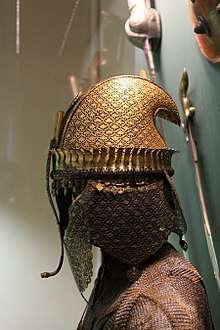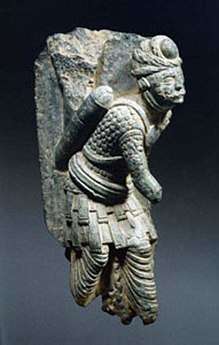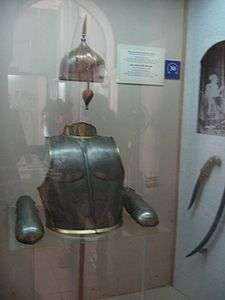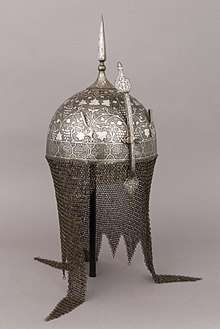Indian armour

Armour in the Indian subcontinent was used since the ancient times. Its earlier reference is found in the Mahabharat.
Mythological armour of Mahabharat (1000 BCE)
In Mahabharata, there are much evidence of using armour during the battles.
- Kavacha
- Karna Kavacha - The armour of Karna that was granted by his father Surya at birth. It was impenetrable even to heavenly weapons.[1]
- Shiva-Kavacha - The armour of Lord Shiva which will make its wielder invincible.
- Khetaka
Before the Gupta period (400 BCE-300 CE)
In the Mauryan era armour was mostly made up of leather and bronze. As a reference of armour was also found during the Alexander's invasion of India. During the Satavahana period the armour was inspired by the armour used by the Indo-Scythians and the Alchon Huns.
Gupta period (320 CE-415 CE)

During the Gupta period scale mail armour used as composed of metal and sometimes leather. Guptas were more than two centuries more advanced than the equipment and technology being depicted here and that their armour was built to withstand torsion-driven steel bows. Siva-Dhanur-Veda discusses the military of the Gupta Empire. The Guptas relied heavily on armoured war elephants; horses were used little if at all. The use of chariots had declined heavily by the time of the Guptas, as they had not proved very useful against the Greeks, Scythians, and other invaders. Guptas utilised heavy cavalry clad in mail armour and equipped with maces and lances, who would have used shock action to break the enemy line.
Late Medieval period (1206 CE-1526 CE)

During 12th century chainmail armour is first introduced in the Indian subcontinent and used by Turkic armies. An reference of chainmail armour was found at Battle of Delhi[3] where it was used by the armoured war elephants.
Early Modern period (1526 CE-1757 CE)
Mughal armour
In 16th century the armour in the Indian subcontinent developed very much. Armour such as chainmail and scale mail are widely used by the Mughals. The use of armour continues until the Battle of Plassey in 1757.[4]
Mughal helmets
Despite the similarity in their design, the Khula Khud helmets were decorated with a wide degree of variations depending on the cultures from which they were created. Decorations often appeared in the skull and the nasal bar, which were often heavily decorated with patterned motifs of inlaid brass, silver or gold; or decorated with figurative images. One Mughal top helmet featured calligraphic inscriptions from the Quran, supposedly to gain "Help from Allah and a speedy victory." A top discovered in Gwalior, India, featured a motif of the skull and crossbones sign of European influence. Another part of the Khula Khud helmet that was often a focus of artistic decoration, was the leaf-shaped finials of the nasal bar. A Sikh top featured the figure of Ganesha carved onto the nasal bar. The Khula Khud helmet was only decorated with some metals, and usually no organic decorations.[5]
Maratha armour
Maratha armour is very similar to the Mughal armour but in the Maratha army, the infantry used armor while the cavalry is always lightly armour. Maratha armour is inspired by the Mughal armour.
References
- ↑ Website dedicated to the story of Karna
- ↑ Sarat Chandra Das (1902). Tibetan-English Dictionary with Sanskrit Synonyms. Calcutta, India: Bengal Secretariat Book Depot, p. 69
- ↑ Jackson, Peter (16 October 2003). The Delhi Sultanate: A Political and Military History. Cambridge University Press. p. 28. ISBN 978-0-521-54329-3.
- ↑ "Mughal Empire". Archived from the original on 2008-02-25.
- ↑ Gahir & Spencer 2006, p. 268.
Further reading
- Roy, Kaushik. From Hydaspes to Kargil: A History of Warfare in India from 326 BC to AD 1999 (2004)
- Sandhu, Gurcharn Singh. Military History of Medieval India (2003)


